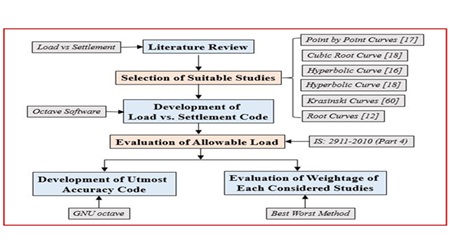Advanced Pile Foundation Design for Disaster Resilience Using Best Worst Method and Computational Modeling

DOI:
https://doi.org/10.54060/a2zjournals.jmce.84Keywords:
Load transfer behavior, Best Worst Method, Pile-soil interface, Octave software, Decision tree modelAbstract
The load transfer behavior at the pile-soil interface is essential for ensuring the stability and resilience of pile foundations, particularly in disaster-prone regions. The allowable load a pile can bear depends on factors such as soil type, pile dimensions, and the in-teraction between the pile and surrounding soil, all of which are critical in maintaining structural integrity during seismic events, floods, and other natural disasters. This study investigates these complexities, proposing innovative approaches to accurately calculate load transfer and optimize disaster resilience strategies. An extensive review of three decades of literature identified six foundational studies on load transfer equations. Load-settlement curves were generated using Octave software, accommodating various soil types and pile dimensions commonly encountered in disaster scenarios. To refine calculations, codes were developed to compute allowable bearing loads using formulas from the Indian Standard code. A decision tree model implemented in Python further predicted the optimal calculation methods for specific conditions under disaster stress scenarios.
Additionally, the research explored six distinct methods for evaluating allowable loads: Point by Point Curve, Cubic Root, Hiramaya Curve, Hyperbolic Curve, Krasinski Curve, and Root Curve. Among these, the Hiramaya Curve emerged as the most con-servative and reliable, offering a higher factor of safety due to its lower allowable load estimates. To enhance accuracy, weightages for each method were evaluated using the Best Worst Method, offering a systematic framework for prioritizing the methods based on their reliability and effectiveness. The findings revealed significant variations in load-bearing capacities across soil types and pile dimensions, emphasizing the necessity of site-specific designs. A novel code was also developed to streamline optimal load calculation methods, improving the efficiency, reliability, and disaster resilience of pile foundation designs. This comprehensive framework equips geotechnical engineers with adaptable tools and robust methodologies to design safer, more resilient structures across diverse geotechnical conditions.
Downloads
References
S.C. Dutta, R. Roy, “A critical review on idealization and modeling for interaction among soil–foundation–structure system”. Computers & structures, Vol. 80, No. 20-21, PP. 1579-1594, 2002.
L.C. Reese, W.M. Isenhower, S.T. Wang, “Analysis and design of shallow and deep foundations”, Vol. 10, John Wiley & Sons, 2005.
H.G. Kempfert, B. Gebreselassie, “Pile foundation”, Excavations and Foundations in Soft Soils, pp. 349-460, 2006.
G. G. Meyerhof, “Bearing capacity and settlement of pile foundations”,” Journal of the Geotechnical Engineering Division, vol. 102, no. 3, pp. 197–228, 1976.
N. S. Mattes and H. G. Poulos, “Settlement of single compressible pile,” J. Soil Mech. Found. Div., vol. 95, no. 1, pp. 189–207, 1969.
H.G. Poulos, E.H. Davis, “Pile foundation analysis and design”, New York: Wiley, Vol. 397, pp. 233-248, 1980.
H. Hirayama, “A unified base bearing capacity formula for piles,” Soils and foundations, Vol. 28, No. 3, pp. 91-102, 1988.
H. Zhu, M.F. Chang, “Load transfer curves along bored piles considering modulus degradation”, Journal of Geotechnical and Geoenvironmental Engineering, Vol. 128, No. 9, pp. 764-774, 2002.
H.M. Coyle, L.C. Reese, “Load transfer for axially loaded piles in clay”, Journal of the soil mechanics and foundations division, Vol. 92, No. 2, pp. 1-26, 1966.
H.M. Coyle, I.H. Sulaiman, “Skin friction for steel piles in sand”, Journal of the Soil Mechanics and Foundations Division, Vol. 93, No. 6, pp. 261-278, 1967.
W.D. Guo, M.F. Randolph, “Rationality of load transfer approach for pile analysis”, Computers and Geotechnics, Vol. 23, No. 1-2, pp. 85-112, 1998.
V.N. Vijivergiya, “Load-movement characteristics of piles”, In 4th Symp. of Waterway, Port, Coastal and Ocean Div., ASCE, Vol. 2, pp. 269-284, 1977.
J.C. Verbrugge, “Évaluation du tassement des pieux à partir de l'essai de pénétration statique”, Revue Française de Géotechnique, Vol. 15, pp. 75-82, 1981.
R. Frank, S.R. Zhao, “Estimating the settlement of axially loaded bored piles in fine sand by PMT data”, Liaison LPC, Vol. 119, 1982.
R. Frank, “Recent developments in the prediction of pile behavior from pressuremeter tests”, From theory to practice on deep foundations, UFRGS, Porto Alegre, Brazil, 1985.
H. Hirayama, “Load-settlement analysis for bored piles using hyperbolic transfer functions”, Soils and Foundations, Vol. 30, No. 1, pp. 55-64, 1990.
American Petroleum Institute (API), “Recommended practice for planning, designing, and constructing fixed offshore platforms–Working stress design”, 20th Edition, Washington, DC, 1993.
C. Bohn, A. Lopes dos Santos, R. Frank, “Development of axial pile load transfer curves based on instrumented load tests”, Journal of Geotechnical and Geoenvironmental Engineering, Vol. 143, No. 1, pp. 04016081, 2017.
M.F. Randolph, C.P. Wroth, “Analysis of deformation of vertically loaded piles”, Journal of the geotechnical engineering division, Vol. 104, No. 12, pp. 1465-1488, 1978.
J.L. Briaud, L. Tucker, “Piles in sand: a method including residual stresses”, Journal of Geotechnical Engineering, Vol. 110, No. 11, pp. 1666-1680, 1984.
Y.K. Chow, “Axial and lateral response of pile groups embedded in nonhomogeneous soils”, International Journal for Numerical and Analytical Methods in Geomechanics, Vol. 11, No. 6, pp. 621-638, 1987.
H.G. Poulos, “Analysis of residual stress effects in piles”, Journal of Geotechnical Engineering, Vol. 113, No. 3, pp. 216-229, 1987.
J.M. Polo, J.L. Clemente, “Pile-group settlement using independent shaft and point loads”, Journal of geotechnical engineering, Vol. 114, No. 4, pp. 469-487, 1988.
P.D. Kiousis, A.S. Elansary, “Load settlement relation for axially loaded piles”, Journal of geotechnical engineering, Vol. 113, No. 6, pp. 655-661, 1987.
S.R. Kaniraj, “A semi-empirical equation for settlement ratio of pile foundations in sand”, Soils and foundations, Vol. 33, No. 2, pp. 82-90, 1993.
Z. Zhou, Z. Zhang, C. Chen, F. Xu, T. Xu, L. Zhu, T. Liu, “Application of load transfer method for bored pile in loess area”, European Journal of Environmental and Civil Engineering, Vol. 26, No. 10, pp. 4457-4475, 2022.
E.G. Balakrishnan, A.S. Balasubramaniam, N. Phien-wej, “Load deformation analysis of bored piles in residual weathered formation”, Journal of geotechnical and geoenvironmental engineering, Vol. 125, No. 2, pp. 122-131, 1999.
S. Kim, S. Jeong, S. Cho, I. Park, “Shear load transfer characteristics of drilled shafts in weathered rocks”, Journal of geotechnical and geoenvironmental engineering, Vol. 125, No. 11, pp. 999-1010, 1999.
W.Y. Shen, Y.K. Chow, K.Y. Yong, “A variational approach for the analysis of pile group–pile cap interaction”, Geotechnique, Vol. 50, No. 4, pp. 349-357, 2000.
G.J. Dyson, M.F. Randolph, “Monotonic lateral loading of piles in calcareous sand”, Journal of Geotechnical and Geoenvironmental Engineering, Vol. 127, No. 4, pp. 346-352, 2001.
L.C. Reese, W.R. Cox, F.D. Koop, “Analysis of laterally loaded piles in sand”, In Offshore Technology Conference, pp. 2080, OTC, 1974.
M.W. O’Neill, J.M. Murchinson, “Fan evaluation of py relationships in sands”, A report to the American Petroleum Institute, 1983.
A.S. Al-Homoud, T. Fouad, A. Mokhtar, “Evaluating accuracy for two empirical methods in predicting settlement of drilled shafts”, Geotechnical & Geological Engineering, Vol. 22, pp. 245-267, 2004.
A.S. Vesic, “Design of pile foundations”, NCHRP synthesis of highway practice, Vol. 42, 1977.
H.G. Poulos, “Settlement of single piles in nonhomogeneous soil”, Journal of the geotechnical engineering division, Vol. 105, No. 5, pp. 627-641, 1979.
Y.E. Mostafa, M.H. El Naggar, “Response of fixed offshore platforms to wave and current loading including soil–structure interaction”, Soil Dynamics and Earthquake Engineering, Vol. 24, No. 4, pp. 357-368, 2004.
M.F. Chang, H. Zhu, “Construction effect on load transfer along bored piles”, Journal of geotechnical and geoenvironmental engineering, Vol. 130, No. 4, pp. 426-437, 2004.
H.J. Kim, J.L.C. Mission, I.S. Park, “Analysis of static axial load capacity of single piles and large diameter shafts using nonlinear load transfer curves”, KSCE Journal of Civil Engineering, Vol. 11, pp. 285-292, 2007.
K. Hyeongjoo, M. Joseleo, S. Youngsun, B. Jaehong, B. Pilsoon, “Axial Load Capacity Prediction of Single Piles in Clay and Sand Layers Using Nonlinear Load Transfer Curves”, Journal of the Korean Society of Geotechnical and Environmental Engineering, Vol. 9, No. 5, pp. 45-52.
Y.C. Chou, Y.M. Hsiung, “A normalized equation of axially loaded piles in elasto-plastic soil”, Journal of Geotechnical Engineering, Vol. 4, No. 1, pp. 1-7, 2009.
A.S. Bradshaw, S. Haffke, C.D. Baxter, “Load transfer curves from a large-diameter pipe pile in silty soil”, In Full-scale testing and foundation design: Honoring bengt h. fellenius, pp. 590-601, 2012.
A. Lim, A. Kwanda, P.P. Rahardjo, “The Study of tz and qz curves on Bored Pile Based on The Results of Instrumented Pile Load Test in Medium and Stiff Clays”, Proceedings of Pile, Vol. 2, No. 4, 2013.
L.C. Reese, M.W. O'NEIL, “Field load tests of drilled shafts”, In International geotechnical seminar on deep foundations on bored and auger piles, Vol. 1, pp. 145-191, 1988.
S. Nanda, N.R. Patra, “Theoretical load-transfer curves along piles considering soil nonlinearity”, Journal of Geotechnical and Geoenvironmental Engineering, Vol. 140, No. 1, pp. 91-101, 2014.
S. Grecu, A. Barari, L.B. Ibsen, “Axial Load-Transfer Curves for Suction Bucket Foundations in Sand”, In ISOPE International Ocean and Polar Engineering Conference, pp. 24-32, 2019.
M.N. Haque, M. Y. Abu-Farsakh, “Development of analytical models to estimate the increase in pile capacity with time (pile setup) from soil properties”, Acta Geotechnica, Vol. 14, pp. 881-905, 2019.
G. Ranjan, A.S.R. Rao, “Basic and applied soil mechanics”, New Age International, 2011.
P.K. Jayasree, K.V. Arun, R. Oormila, H. Sreelakshmi, “Lateral load capacity of piles: a comparative study between indian standards and theoretical approach”, Journal of The Institution of Engineers (India): Series A, Vol. 99, pp. 587-593, 2018.
A. Krasiński, “Proposal for calculating the bearing capacity of screw displacement piles in non-cohesive soils based on CPT results”, Studia Geotechnica et Mechanica, Vol. 34, No. 4, pp. 41-51, 2012.
B. Charbuty, A. Abdulazeez, “Classification based on decision tree algorithm for machine learning”, Journal of Applied Science and Technology Trends, Vol. 2, No. 1, pp. 20-28, 2021.
K.K. Rana, “A survey on decision tree algorithm for classification”, International journal of Engineering development and research, Vol. 2, No. 1, pp. 1-5, 2014.
J. Rezaei, “Best-worst multi-criteria decision-making method”, Omega, Vol. 53, pp. 49–57, 2015.

Downloads
Published
How to Cite
CITATION COUNT
Issue
Section
License
Copyright (c) 2025 Gitartha Kalita, Palash Jyoti Hazarika

This work is licensed under a Creative Commons Attribution 4.0 International License.
























